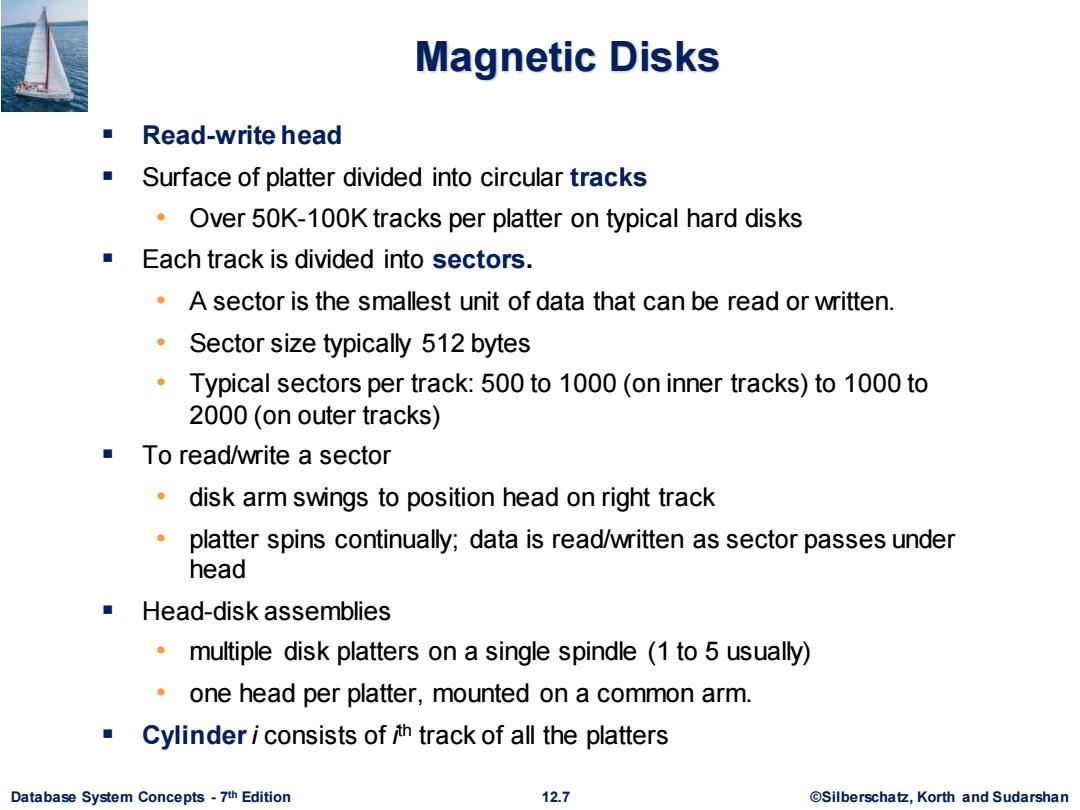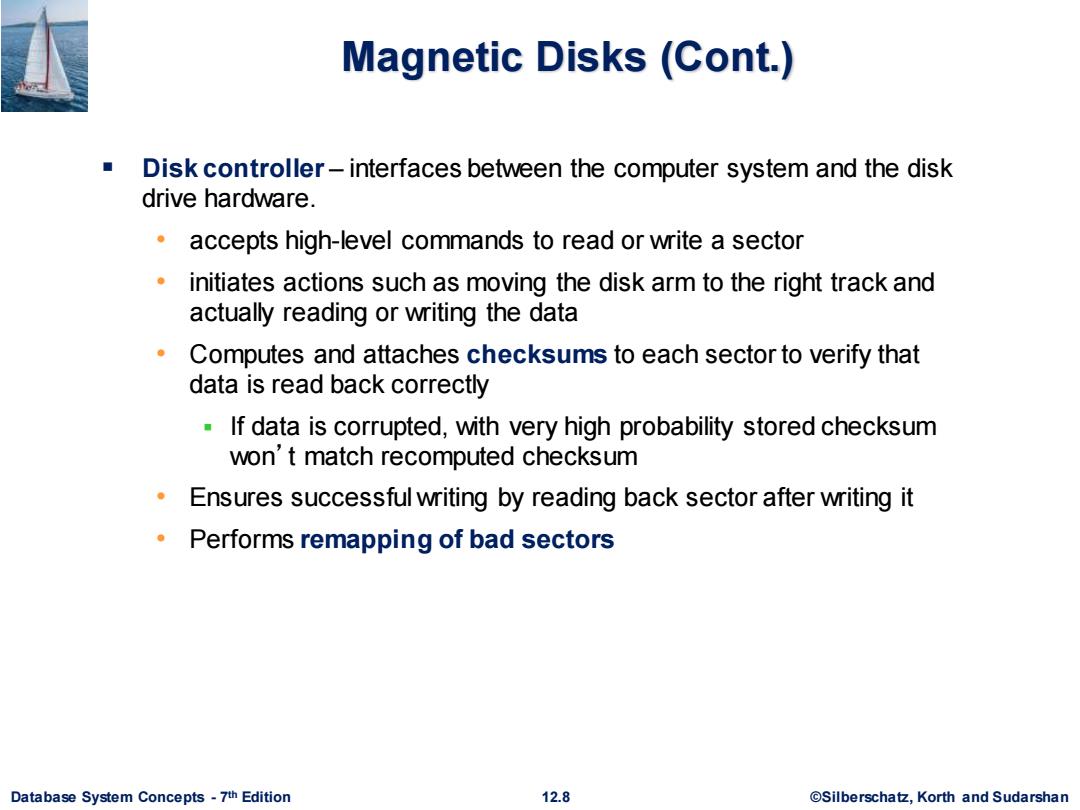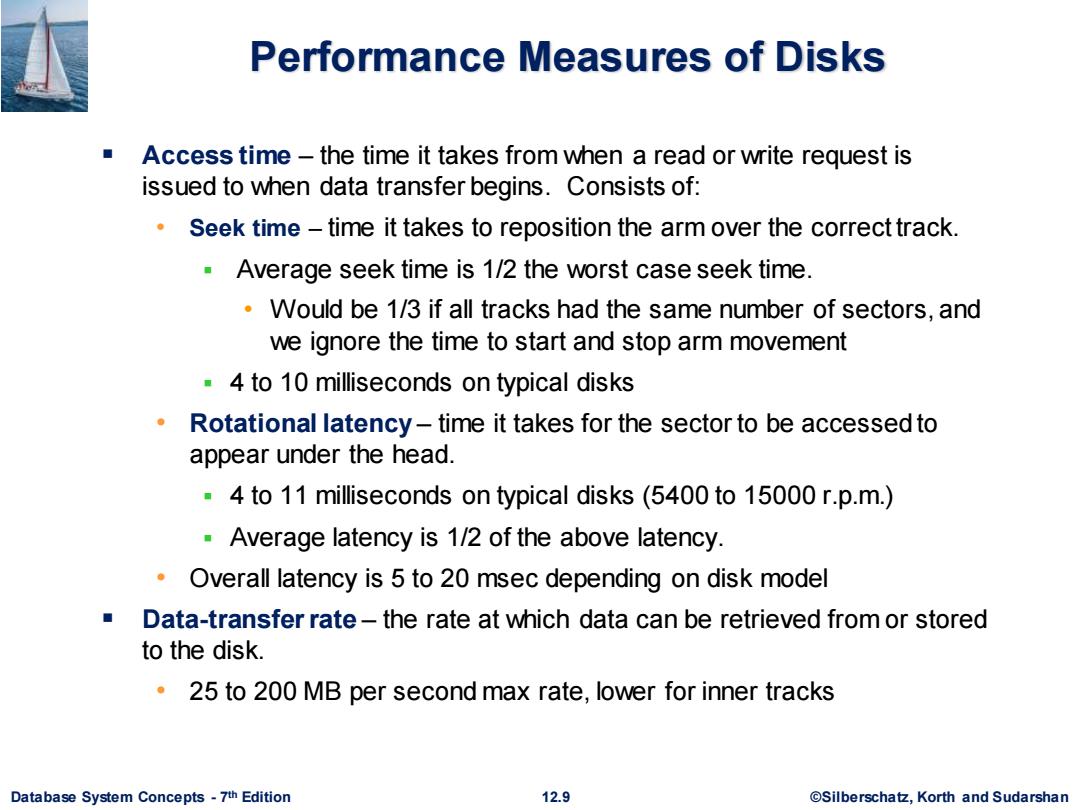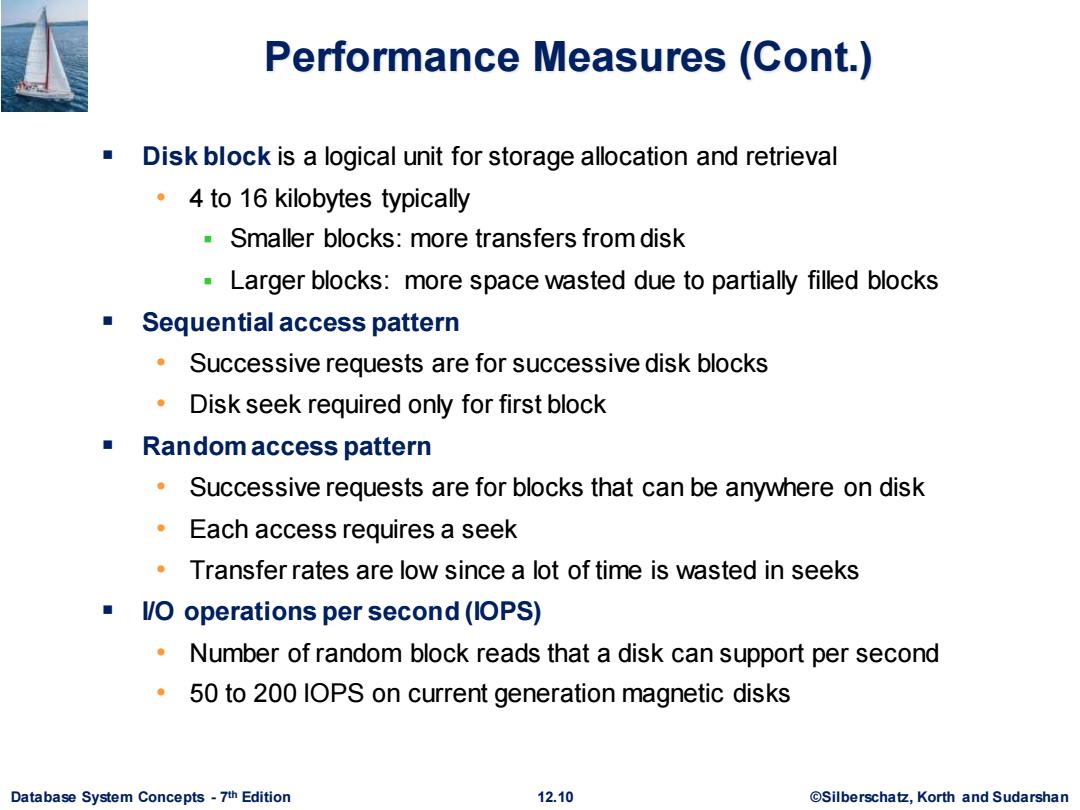
Magnetic Disks ■Read-write head Surface of platter divided into circular tracks Over 50K-100K tracks per platter on typical hard disks Each track is divided into sectors. A sector is the smallest unit of data that can be read or written. Sector size typically 512 bytes Typical sectors per track:500 to 1000(on inner tracks)to 1000 to 2000(on outer tracks) ■To read/rite a sector disk arm swings to position head on right track platter spins continually;data is read/written as sector passes under head Head-disk assemblies multiple disk platters on a single spindle (1 to 5 usually) one head per platter,mounted on a common arm. Cylinder i consists of ith track of all the platters Database System Concepts-7th Edition 12.7 ©Silberscha乜,Korth and Sudarshan
Database System Concepts - 7 12.7 ©Silberschatz, Korth and Sudarshan th Edition Magnetic Disks ▪ Read-write head ▪ Surface of platter divided into circular tracks • Over 50K-100K tracks per platter on typical hard disks ▪ Each track is divided into sectors. • A sector is the smallest unit of data that can be read or written. • Sector size typically 512 bytes • Typical sectors per track: 500 to 1000 (on inner tracks) to 1000 to 2000 (on outer tracks) ▪ To read/write a sector • disk arm swings to position head on right track • platter spins continually; data is read/written as sector passes under head ▪ Head-disk assemblies • multiple disk platters on a single spindle (1 to 5 usually) • one head per platter, mounted on a common arm. ▪ Cylinderi consists of i th track of all the platters

Magnetic Disks (Cont.) Disk controller-interfaces between the computer system and the disk drive hardware. accepts high-level commands to read or write a sector initiates actions such as moving the disk arm to the right track and actually reading or writing the data 。 Computes and attaches checksums to each sector to verify that data is read back correctly If data is corrupted,with very high probability stored checksum won't match recomputed checksum Ensures successful writing by reading back sector after writing it Performs remapping of bad sectors Database System Concepts-7th Edition 12.8 ©Silberscha乜,Korth and Sudarshan
Database System Concepts - 7 12.8 ©Silberschatz, Korth and Sudarshan th Edition Magnetic Disks (Cont.) ▪ Disk controller – interfaces between the computer system and the disk drive hardware. • accepts high-level commands to read or write a sector • initiates actions such as moving the disk arm to the right track and actually reading or writing the data • Computes and attaches checksums to each sector to verify that data is read back correctly ▪ If data is corrupted, with very high probability stored checksum won’t match recomputed checksum • Ensures successful writing by reading back sector after writing it • Performs remapping of bad sectors

Performance Measures of Disks Access time-the time it takes from when a read or write request is issued to when data transfer begins.Consists of: Seek time-time it takes to reposition the arm over the correcttrack. Average seek time is 1/2 the worst case seek time. Would be 1/3 if all tracks had the same number of sectors,and we ignore the time to start and stop arm movement 4 to 10 milliseconds on typical disks Rotational latency-time it takes for the sector to be accessed to appear under the head. 4 to 11 milliseconds on typical disks (5400 to 15000 r.p.m.) Average latency is 1/2 of the above latency. Overall latency is 5 to 20 msec depending on disk model ■ Data-transfer rate-the rate at which data can be retrieved from or stored to the disk. 25 to 200 MB per second max rate,lower for inner tracks Database System Concepts-7th Edition 12.9 ©Silberscha乜,Korth and Sudarshan
Database System Concepts - 7 12.9 ©Silberschatz, Korth and Sudarshan th Edition Performance Measures of Disks ▪ Access time – the time it takes from when a read or write request is issued to when data transfer begins. Consists of: • Seek time – time it takes to reposition the arm over the correct track. ▪ Average seek time is 1/2 the worst case seek time. • Would be 1/3 if all tracks had the same number of sectors, and we ignore the time to start and stop arm movement ▪ 4 to 10 milliseconds on typical disks • Rotational latency – time it takes for the sector to be accessed to appear under the head. ▪ 4 to 11 milliseconds on typical disks (5400 to 15000 r.p.m.) ▪ Average latency is 1/2 of the above latency. • Overall latency is 5 to 20 msec depending on disk model ▪ Data-transfer rate – the rate at which data can be retrieved from or stored to the disk. • 25 to 200 MB per second max rate, lower for inner tracks

Performance Measures (Cont.) Disk block is a logical unit for storage allocation and retrieval 4 to 16 kilobytes typically Smaller blocks:more transfers from disk Larger blocks:more space wasted due to partially filled blocks Sequential access pattern Successive requests are for successive disk blocks Disk seek required only for first block Random access pattern Successive requests are for blocks that can be anywhere on disk Each access requires a seek Transfer rates are low since a lot of time is wasted in seeks l/O operations per second(IOPS) Number of random block reads that a disk can support per second 50 to 200 IOPS on current generation magnetic disks Database System Concepts-7th Edition 12.10 @Silberschatz,Korth and Sudarshan
Database System Concepts - 7 12.10 ©Silberschatz, Korth and Sudarshan th Edition Performance Measures (Cont.) ▪ Disk block is a logical unit for storage allocation and retrieval • 4 to 16 kilobytes typically ▪ Smaller blocks: more transfers from disk ▪ Larger blocks: more space wasted due to partially filled blocks ▪ Sequential access pattern • Successive requests are for successive disk blocks • Disk seek required only for first block ▪ Random access pattern • Successive requests are for blocks that can be anywhere on disk • Each access requires a seek • Transfer rates are low since a lot of time is wasted in seeks ▪ I/O operations per second (IOPS) • Number of random block reads that a disk can support per second • 50 to 200 IOPS on current generation magnetic disks

Performance Measures (Cont.) 加 Mean time to failure(MTTF)-the average time the disk is expected to run continuously without any failure. ·Typically3to5 years Probability of failure of new disks is quite low,corresponding to a "theoretical MTTF"of 500,000 to 1,200,000 hours for a new disk E.g.,an MTTF of 1,200,000 hours for a new disk means that given 1000 relatively new disks,on an average one will fail every 1200 hours MTTF decreases as disk ages Database System Concepts-7th Edition 12.11 ©Silberscha乜,Korth and Sudarshan
Database System Concepts - 7 12.11 ©Silberschatz, Korth and Sudarshan th Edition Performance Measures (Cont.) ▪ Mean time to failure (MTTF) – the average time the disk is expected to run continuously without any failure. • Typically 3 to 5 years • Probability of failure of new disks is quite low, corresponding to a “theoretical MTTF” of 500,000 to 1,200,000 hours for a new disk ▪ E.g., an MTTF of 1,200,000 hours for a new disk means that given 1000 relatively new disks, on an average one will fail every 1200 hours • MTTF decreases as disk ages